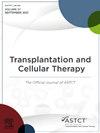A Retrospective Study of Pediatric Patients With Low- or Intermediate-Risk Acute Myeloid Leukemia Who Underwent Allogeneic Hematopoietic Cell Transplantation for the AML-05 Study Conducted by the Japanese Pediatric Leukemia/Lymphoma Study Group
IF 3.6
3区 医学
Q2 HEMATOLOGY
引用次数: 0
Abstract
The AML-05 study aimed to examine the efficacy and safety of a therapeutic strategy based on risk stratification for low-, intermediate-, or high-risk acute myeloid leukemia (AML) pediatric patients. Allogeneic hematopoietic cell transplantation (allo-HCT) was not indicated for low- or intermediate-risk AML patients in first complete remission. The present retrospective study for the AML-05 study aimed to identify prognostic factors for survival and to determine optimal allo-HCT according to multivariate analysis on overall survival (OS), event-free survival (EFS), cumulative incidence of relapse (CIR), and cumulative incidence of nonrelapse mortality for and between low- and intermediate-risk AML group patients in the AML-05 study who had undergone allo-HCT after its completion and relapse. The unique patient numbers (UPNs) of the AML-05 study were matched with the Transplant Registry Unified Management Program (TRUMP)-registered numbers, and the tied data on the AML-05 study's UPNs and the TRUMP-registered numbers were analyzed. The primary endpoint was 3-yr OS. Among 443 AML patients in the AML-05 study, 79 (32 low-risk AML and 47 intermediate-risk AML) were analyzed. The following statistically favorable prognostic factors were identified by multivariate analysis on the low- and intermediate-risk AML groups, respectively: UCB (OS—hazard ratio [HR], 0.105; 95% CI, 0.011 to 0.941; P = .004 and EFS—HR, 0.065, 95% CI, 0.007 to 0.577, P = .014) and late relapse (OS—HR, 0.212; 95% CI, 0.072 to 0.626; P = .005 and EFS—HR, 0.236; 95% CI, 0.088 to 0.630; P = .004). Three-year OS, 3-yr EFS, and 3-yr CIR were significantly different between the low- and intermediate-risk AML groups. UCB may be a safe and beneficial donor source for low-risk AML patients, while late relapse was a favorable prognostic factor for intermediate-risk AML patients. Intermediate-risk AML patients with late relapse and low-risk AML patients may benefit from allo-HCT after relapse.
日本儿科白血病/淋巴瘤研究小组开展的 AML-05 研究中,对接受异基因造血细胞移植的低危或中危急性髓性白血病儿科患者进行的回顾性研究。
AML-05研究旨在考察基于风险分层的治疗策略对低危、中危或高危急性髓性白血病(AML)儿科患者的疗效和安全性。同种异体造血细胞移植(allo-HCT)不适用于首次完全缓解(CR1)的低危或中危急性髓性白血病患者。本项AML-05研究的回顾性研究旨在确定生存预后因素,并根据对AML-05研究中低危和中危AML组患者完成异基因造血干细胞移植后复发的总生存期(OS)、无事件生存期(EFS)、累计复发率(CIR)和非复发死亡率(NRM)的多变量分析,确定最佳的异基因造血干细胞移植。AML-05研究的唯一患者编号(UPN)与移植登记处统一管理计划(TRUMP)登记的编号进行了匹配,并对AML-05研究的UPN和TRUMP登记编号的绑定数据进行了分析。主要终点是3年的OS。在AML-05研究的443名急性髓细胞性白血病患者中,有79人(32名低危急性髓细胞性白血病患者和47名中危急性髓细胞性白血病患者)接受了分析。通过对低风险 AML 组和中风险 AML 组进行多变量分析,分别发现了以下统计学上有利的预后因素:UCB(OS-危险比[HR],0.105;95% CI,0.011 至 0.941;P = .004;EFS-HR,0.065,95% CI,0.007 至 0.577,P = .014)和晚期复发(OS-HR,0.212;95% CI,0.072 至 0.626;P = .005;EFS-HR,0.236;95% CI,0.088 至 0.630;P = .004)。低危和中危急性髓细胞性白血病组的三年 OS、三年 EFS 和三年 CIR 有显著差异。对于低风险急性髓细胞白血病患者来说,UCB可能是一种安全、有益的供体来源,而对于中度风险急性髓细胞白血病患者来说,晚期复发是一个有利的预后因素。晚期复发的中危急性髓细胞性白血病患者和低危急性髓细胞性白血病患者可能会在复发后从异体血细胞移植中获益。
本文章由计算机程序翻译,如有差异,请以英文原文为准。
求助全文
约1分钟内获得全文
求助全文
来源期刊

Transplantation and Cellular Therapy
Medicine-Hematology
CiteScore
7.00
自引率
15.60%
发文量
1061
审稿时长
51 days
 求助内容:
求助内容: 应助结果提醒方式:
应助结果提醒方式:


